Theme Parks & Themed Entertainment
Did Disneyland inspire the Universal Studio Tour in Hollywood? Or was it actually the other way around?

What with James Cameron's tour of Disney's Animal Kingdom on
October 17th (which was then followed by this Academy Award-winner's
visit to Universal's Island of Adventure on October 18th), the Web
has once again been a-buzz with stories about how The World of Avatar is
supposed to be Mickey's answers to The Wizarding World of Harry Potter. More
importantly, how Disney's now-decades-long grudge match with Universal shows absolutely
no sign of abating.
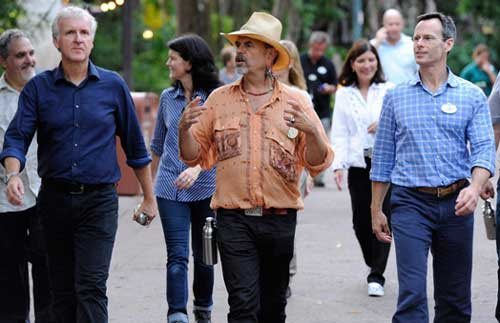
(L to R) James Cameron, Joe Rohde and Thomas Staggs on a walk-thru of Disney's
Animal Kingdom. Copyright Disney Enterprises, Inc. All rights reserved
Well, while it is true that things have been a bit testy
between these two media giants ever since February of 1985 (which was when
Michael Eisner revealed his plan to add a studio tour to WDW's
assortment of attractions. Which would then put the Mouse in direct competition with
that movie-based theme park which Universal had been planning on building in
Orlando since back in 1979). But these two mega-corporations weren't always mortal
enemies. In fact, there were times over the past 90 years when relations were
downright cordial between Disney & Universal.
Mind you, that's probably because – back when he was still living
in Kansas City – Walt Disney used to be a newsreel stringer. Which meant that –
when there was some local event worth noting (EX: hundreds of Shriners parading up Petticoat Lane as their
annual convention drew to a close) – Walt would then grab his camera and then get
some footage of the event. Which — being the enterprising young man that he
was — Disney would now try to sell to Kansas City theater owners so that they
could then add a little local color to their nightly presentation.
And Walt was able to do this enough times (i.e. selling
live-action footage that he'd shot around town. Most notably to the movie
theaters that were affiliated with Selznick Studios & Universal Pictures)
that he actually had some business cards made up which stated that Disney was the
official Kansas City rep for Selznick & Universal's newsreels.
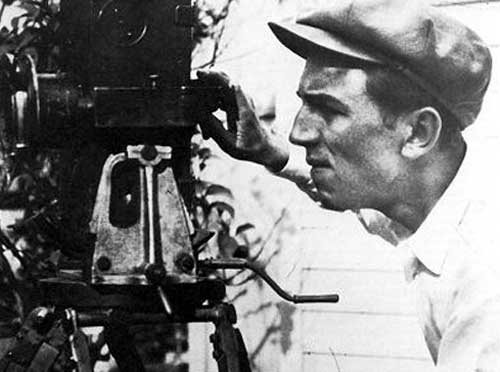
Copyright Disney Enterprises, Inc. All rights reserved
Which obviously wasn't true. But given that Walt was hoping
to someday make a name for himself in Hollywood, a town whose currency is hype
& hyperbole … I guess we can overlook the fact that this then-22-year-old
inflated his resume.
Now let's jump ahead to August of 1923. When Walt is
actually out in Southern California, actively trying to break into the
biz. And since the only way that a new kid in town like him will ever get
a really-for-real movie producer to look at his work is by "accidentally"
bumping into them on the studio lot … Well, that's what Disney decided to try & do.
So clutching his completely bogus
official-Kansas-City-rep-for-the-Selznick-and-Universal-newsreel business
cards, Walt catches the trolley for the San Fernando Valley and soon finds
himself outside the gates of Universal Studios. Where – after presenting
his business card and slinging a fine line of bull at the guard who is manning that
gate – Walt is then given a lot pass. Which basically allowed this future movie
mogul to wander the length & breadth of Universal City.
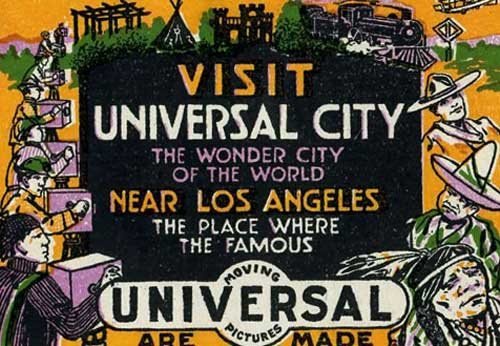
Copyright Universal Studios, Inc. All rights reserved
Now let's pause for a moment here to put ourselves in Walt
Disney's shoes: You're a kid just in from Kansas City. You're always dreamed of
someday making the trip to Hollywood and then getting the chance to make
movies. And you've just now managed to con your way onto the lot of one of the
biggest, busiest studios in town.
Harrison "Buzz" Price (i.e. the Disney Legend who – in his
role as a research economist – helped Walt pick the site of Disneyland in 1953
and Walt Disney World in 1963) once told me about a conversation that he had
with the Old Mousestro while the two of them were on the Disney corporate plane
in the early 1960s. If I remember correctly, Buzz and Walt were flying out to
the East Coast to take part in some meetings related to the 1964 New York
World's Fair when they had this chat.
Anyway … Over a couple of Scotch Mists, Disney started
reminiscing about his early, early days in Hollywood. In particular, Walt began
talking about the days that he spent wandering around Universal City.
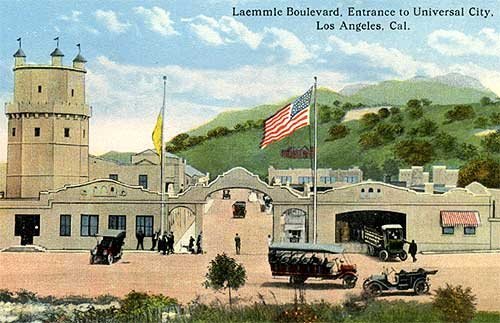
Copyright Universal Studios, Inc. All rights reserved
And – yes – I said "days." According to what Disney
reportedly told Price, Walt spent three days exploring the Universal lot
until the guard at the front gate finally got suspicious and made him
surrender his pass. And while Disney did spend a lot of time while he was on
that lot knocking on doors, trying to get producers & executives to look at
his "Alice Comedies" proof-of-concept reel, Walt also spent much of those three
days wandering from set to set, looking in on Universal's various production
teams as they worked.
And as Price listened to Disney describe it was to be
walking down one of Universal's western sets and then turn a corner &
suddenly find yourself in 15th century Paris, on the massive outdoor
set that Universal's artists & craftsmen had just built for Lon Chaney's "The Hunchback Of Notre Dame" … Well, it then occurred to Buzz that those three days
that Walt spent exploring the Universal lot obviously had a strong influence on the
look & feel of Disneyland.
Of course, what's kind of ironic about this particular story
is that – back in early 1955 – when the bankers were quizzing Roy O. Disney
about what the Company's contingency plans were if Disneyland failed to catch
on with the public, Roy reportedly replied with "We'll just shoot our movies
& TV shows out here. We'll also rent the place out to other production
companies. They can shoot their westerns in Frontierland and medieval adventures out in
front of the castle. We'll figure out a way to make some money off of this
place."
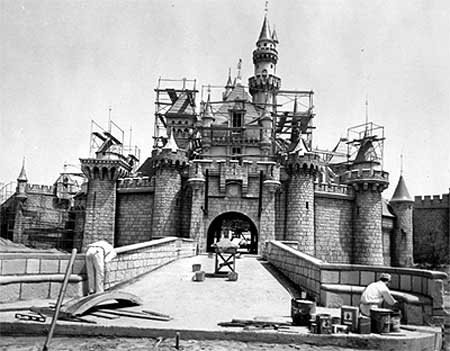
Construction of Sleeping Beauty Castle nears completion in the Spring of 1955.
Copyright Disney Enterprises, Inc. All rights reserved
So if Disneyland hadn't succeeded, it might have then become
the Anaheim equivalent of Universal Studios. Which – come to think about it –
is actually what happened in April of 1962. Which is when Walt allowed director
Norman Jewison and a film crew from Universal to spend two weeks shooting in
& around the Happiest Place on Earth for the Tony Curtis comedy, "40 Pounds of Trouble."
But I'm kind of getting ahead of myself here … So let's get
back now to Walt Disney and his ties to Universal Studios. Which – as the 1920s
continued on – just got stronger & stronger.
To explain: After the "Alice Comedies" had kind of run their
course, Walt created a new cartoon character — Oswald the Lucky Rabbit
– which
he hoped to then build a new series of animated theatrical shorts around. Disney and
his team created a prototype "Oswald" cartoon, "Poor Papa," which Charles Mintz
(i.e. their "Alice Comedies" producer) was then able to get screened for
Universal Studios founder Carl Laemmle.
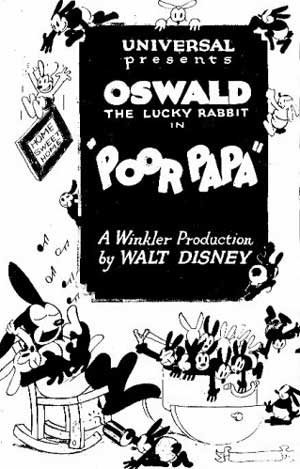
Copyright Disney Enterprises, Inc. All rights reserved
And Laemmle – who was anxious for Universal to have a cartoon series of its own
that could compete against the then-hugely popular "Felix the Cat" and "Koko the Clown" animated theatrical shorts – agreed to take Oswald on. But only
after Carl had given Charles & Walt extensive notes about how to they could
improve the appeal of this character (EX: make Oswald younger & less sloppy
and fat). The second Oswald cartoon, "Trolley Trouble" sealed the deal. Mintz
& Disney then signed a deal with Laemmle which promised that they'd produce
26 "Oswald the Lucky Rabbit" cartoons which Universal Pictures would then
release.
And throughout much of 1927 & 1928, Walt Disney was
reportedly very happy with this deal. Not only because the "Oswald" series
quickly became a hit with moviegoers. But also because the animated shorts that
Walt and his team were producing were being released by a major studio like
Universal Pictures. Which — to Disney's way of
thinking — meant that he'd finally made the big time in Hollywood.
But then – of course – this all came crashing down in the
Spring of 1928, when Walt (buoyed by "Oswald" 's box office success) traveled
to New York City with the hope that he could then persuade Charles to not only give
the Disney Brothers Studio team a raise but also increase the production budget
of the next round of "Lucky Rabbit" cartoons. But Mintz had another idea in
mind. For he actually proposed a 20% reduction in the amount of money that Disney & his
crew was spending on each "Oswald" cartoon.
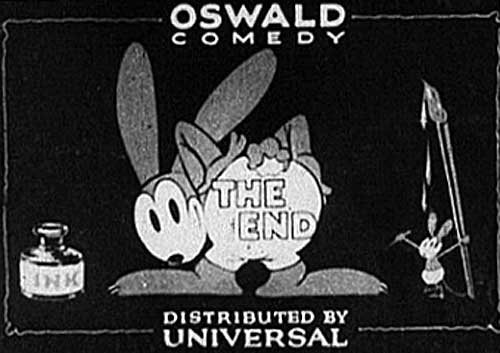
Copyright Disney Enterprises, Inc. All rights reserved
When Walt balked, Charles advised him to take a look at his
contract. Which then revealed that it was Universal – not Disney – who actually owned
the rights to the Oswald-the-Lucky-Rabbit character. What's more, Mintz had
secretly hired away most of the animators that worked for Disney Brothers
Studio. Leaving Walt with very few cards to play in this genuinely awful
situation.
Of course, as any Disney history buff can tell you, it was
directly after this meeting in NYC with Mintz – on Disney's long sad train trip
back to Hollywood — that Walt initially dreamed up Mickey Mouse. So this story
has kind of a happy ending. Kind of.
But from a history point of view, where this tale gets interesting is that – while Disney
despised Charles Mintz for his underhanded dealings in the "Oswald" situation –
he bore no ill will against Carl Laemmle & Universal. After all, Walt had willingly
signed the contract for that cartoon series. More importantly, it was Disney's
own fault that he hadn't read the fine print and learned that it was Universal
Pictures, rather than Disney Brothers Studio, that retained all rights
to the Oswald-the-Lucky-Rabbit character.

Copyright Disney Enterprises, Inc. All rights reserved
But as Walt was famous for saying: "You may not realize it
when it happens, but a kick in the teeth may be the best thing in the world for
you." And the hard lesson that he learned in the Spring of 1928 helped shape the
way that The Walt Disney Company deals with intellectual property. Even today,
Disney's attorneys are famous for the convoluted contracts that they craft. Which then virtually guarantee that the Company retains the rights to any &
all characters which the Studio's employees create.
Of course, back when he was working in the 1920s &
1930s, Walt had absolutely no idea that the characters – more importantly, the
films that his studio was creating — would have the shelf life that they
enjoy today. Believe it or not, Disney actually assumed that the animated
features which his Company was producing would be like all of the
other movies that Hollywood was producing at this time. In that they could only be
released theatrically once … And after that … Well, that was pretty much it.
According to Neal Gabler, the author of "Walt Disney: The Triumph of the American Imagination," what changed Walt's attitude on this
matter was 1930's "Dracula" and 1931's "Frankenstein." Or – rather – the huge
amount of money that Universal Studios made when they repackaged these classic
horror films as a double feature and then sent them back out into theaters in
1938.
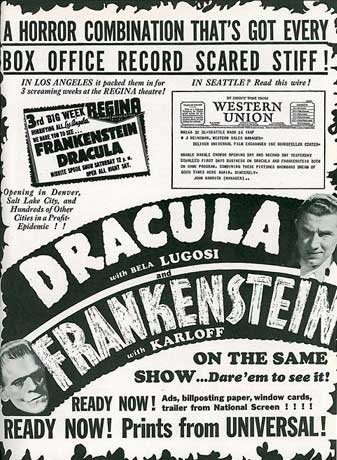
Copyright Universal Studios, Inc. All rights reserved
Mind you, Walt didn't look at that "Dracula / Frankenstein"
double bill and then – all on his own – come up with the idea of putting past
Disney hits like "Snow White" and "Pinocchio" back in theaters. According to
Gabler, it was an WWII-era encounter with a Universal executive that actually
set those wheels in motion:
While coming back on the train from one of his Washington
trips in 1942, (Walt) had met Nate Blumberg, the head of Universal Pictures,
who had told Walt how Universal had mined its old film library for pictures
they could reissue and advised the Disney Studio to do the same. Walt (then)
prodded Roy on this matter, asking him to consider re-releasing Snow White and
possibly some of the other features for Christmas in 1943. Roy finally agreed
on Snow White, though the Company missed the holiday season and opened it
instead in February 1944.
And it was this one change in attitude, thinking of the films
that Walt Disney Studios produced not so much as dairy products (i.e. things
that had a limited shelf life, that you used once and then discarded) but – rather – as
long-term assets which then allowed the Mouse Factory to make it through the
late 1940s & early 1950s. When television suddenly arrived on the scene and
the movie game changed forever.
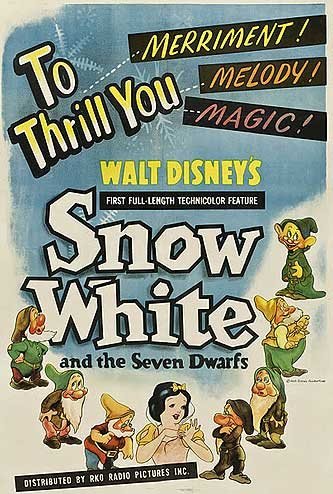
The poster for the 1944 re-release of "Snow White and the
Seven Dwarfs." Copyright Disney Enterprises, Inc.
All rights reserved
And helping Walt through this extremely tumultuous time in
the entertainment industry's history was Jules Stein, the head of the Music
Corporation of America AKA MCA. So when the Old Mousetro began thinking about
getting into television in 1952 (to help finance the construction of
Disneyland), it was Stein who helped open the doors for Disney at CBS, NBC and
ABC. And if the stories that Company old-timers have told me are true, Jules
not only brokered the deal for American Broadcasting executives (which – in exchange
for producing a weekly "Disneyland" TV series for ABC – Walt got $500,000 in
cash as well as $4.5 million in loans which he could then use to fund the
construction of his project in Anaheim), Stein also got MCA to kick in a little
seed money for that theme park as well.
And Walt never ever forgot about how helpful Jules had been, the
key role that this Hollywood mover-and-shaker had played when it came to moving
Disney Studios to the next level. Not to mention how personally helpful Stein
had been towards the Disney family (EX: when Roy E. Disney graduated from
Pomona College in 1951, Jules had the then-president of MCA, Lew Wasserman,
call around and find Walt's nephew a job in the industry. Which is how Roy E.
wound up at a page at NBC).
Which is why – after MCA had merged with Decca Records in 1962 and thus became
the owner of Universal Pictures as well as of that studio's 423-acre backlot –
Walt was pleased to get a call from Jules. Asking him to come over the hill so
that these two studio heads could then go for a stroll around the Universal
lot.

Copyright Universal Studios, Inc. All rights reserved
Now as Buzz Price told me this story, as Jules walked with
Walt around the backlot, he explained that he wanted to pick Disney's brain.
You see, MCA was toying with the idea of reviving Universal's studio tour
(which had been such a moneymaker for the Company back in the 1920s). And since
the success of Disneyland had now made Walt the world's leading authority on
what tourists would really respond to, Jules wanted to know: Did the backlot have the makings of an attraction? Did Disney think Southern California visitors would pay for the privilege of visiting Universal City and then see how movies & TV shows are really
made? Or are people in the oh-so-sophisticated 1960s just too jaded now to be sucked in by that sort of Hollywood hokum?
And it was at this point in their walk that Walt supposedly told Jules
about his own visit to Universal Studios nearly 40 years earlier. How he had
spent three days exploring the backlot, looking on in various sets. He made a point of saying that this
early Hollywood escapade had been one of the big thrills of his life. Which was
why Disney was certain that the public would still love to get the chance to walk
through Universal's gates and then see what went on behind-the-scenes.
Of course, to get some sense of how many people would
really be interested in visiting a Universal Studios Tour attraction (more
importantly, what they'd be willing to pay to get in), Disney suggested that
Stein reach out to Price's firm and have this research economist run the
numbers for MCA. And given that the backlot was looking pretty ratty in spots
during their walk-thru, Walt then told Jules hire a designer to unify
Universal's looks. Spruce the place up a bit. Or – at the very least – give the studio tour a strong
starting-off point as well as a big finish.
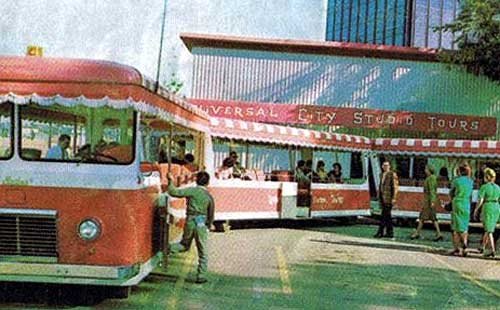
Copyright Universal Studios, Inc. All rights reserved
And Stein followed each and every one of Disney's suggestions.
Turning to Albert Dorskind (i.e. the longtime MCA executive who had noodging
upper management for years about how they should revive the Universal Studios
Tour), Jules ordered Albert to reach out to Buzz Price's company and commission
a study. Stein also had Dorskind hire Harper Goff (i.e. the future Disney
Legend who not only designed the Nautilus for Disney's "20,000 Leagues Under The Sea" but also helped Imagineer Disneyland's Main Street, U.S.A. area &
Jungle Cruise attraction) to develop a distinctive look & transportation
system for this proposed Universal our.
And two years and $4 million later, the Universal City
Studio Tours officially opened for business in June of 1964. For the princely sum of just
$2.50 for adults and $1.50 for children, you could climb aboard the Goff-designed
Glamour Tram and then head out for a 90 minute-long adventure. Which – at that time,
anyway – included a walk-thru of a faux version of Doris Day's dressing room.
Not to mention a chance to dine-with-the-stars by grabbing a quick lunch at the
Universal Pictures commissary.
As for Jules & Walt, they stayed friends 'til the day
that Disney died in December 15, 1966. With Walt being a big support of Jules'
philanthropic efforts (which explains that Mary-Blair-designed mosaic which you'll
find decorating one of the waiting rooms at UCLA's Jules Stein Eye Institute).
And Stein … Well, given that he was such a big believer in Disney's magical
touch, Jules was always calling Walt with new projects that he thought the Old
Mousetro should take on. Like the time Stein phoned Disney and suggested that he
buy the then-abandoned Ellis Island complex and turn into an off-shore
Disneyland for New Yorkers.

But Walt didn't always listen to Jules' suggestions. In
fact, Disney deliberately ignored Stein's advice when it came to the subject of
EPCOT. When Jules learned of Walt's plan to build a futuristic city as part of
his Florida Project, Stein immediately got Disney on the phone and told him
flat-out not to go ahead with that aspect of Disney World. That if the
bureaucratic red tape which Jules had to deal with on a daily basis because
Universal City had been incorporated were any indication, Walt was in for years
of headaches & heartache.
But as it turned out, Disney didn't have years. He had
months. And Stein … Well, while he tried to keep the lines of communication
open with Disney Studios after Walt died … To be blunt, Jules just didn't have the same sort of
long-term friendship / good working relationship with Roy O. that he did with
Walt. And when Disney's brother died in December of 1971 and Stein retired from
Universal in 1973, relations slowly began to deteriorate between the two
companies.
Mind you, Disney Studios and Universal Pictures could still occasionally work together. But only at times when one or more of these media giants felt
threatened. Take – for example – when Disney & Universal jointly sued Sony
in 1976. All because these two studios saw the Betamax video recorder as a
direct threat when it came to maintaining the long-term value of their film libraries.
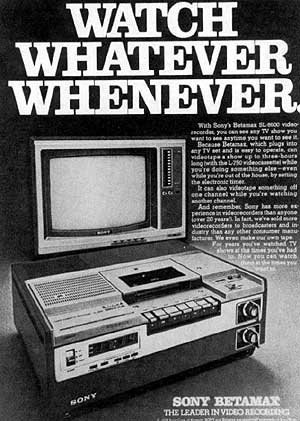
Copyright Sony, Inc. All rights reserved
But perhaps the strangest times that Disney & Universal came
together was in 1984. Which was when the Mouse – as it found itself under attack from
greenmailers like Saul P. Steinberg & Irwin Jacobs – began searching for
safe harbors. Which – in this instance, anyway – meant quickly finding a way to make
Walt Disney Productions a far less attractive target for acquisition.
And one of the easiest ways to do this was by merging with a
competitor. In effect making Disney too big to buy. Which was what Ron Miller
& Card Walker were trying to do when they reached out to Lew Wasserman (who
was now Jules Stein's successor) and asking him if MCA / Universal would be
interested in acquiring Walt Disney Studios.
As Connie Bruck recounts in her 2003 book, "When Hollywood Had a King: The Reign of Lew Wasserman, Who Leveraged Talent into Power and Influence," Wasserman was interested in acquiring Disney. And this deal came within inches of actually happening. Only to then be derailed at virtually the last minute due to Lew's stubbornness:
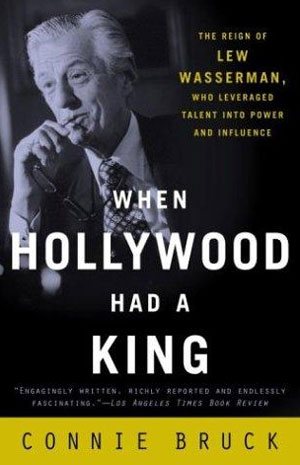
Copyright Random House, Inc. All rights reserved
"All the terms were done," said Barry Diller, who
had learned what happened from one of the principals. "But the Disney
family said that Ron Miller [a Disney executive] had to be president. Sid
[Sheinberg] said to Lew, 'It's fine.' Felix [Rohatyn, the investment banker
advising MCA] said to Lew, 'Do it – a year from now, you'll get rid of Miller,
and make Sid President.' But Lew said 'No. Sidney is president.'
"It was Lew's inflexibility that caused him to blow
deals he should not have blown," Diller added. "He and Jules [Stein]
had built the best company – they should have owned the world. And had they
made this deal with Disney, everything would have been different."
Now contrast this with what happened just one year later
when Ron Miller was out and Michael Eisner was now in charge of the Mouse
House. Within three months of coming to power at Disney, Eisner announced that
Walt Disney World would soon be adding a studio tour to its already large
assortment of attractions.
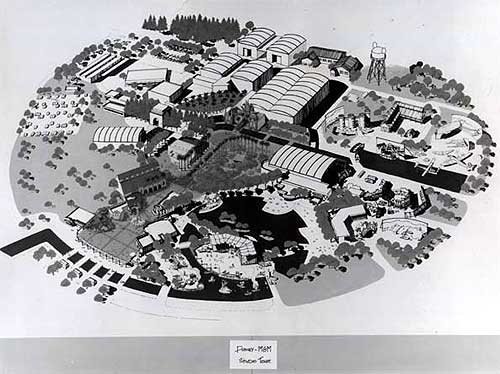
Concept art for the 1985 version of the Disney MGM Studio Tour. Copyright Disney
Enterprises, Inc. All rights reserved
"And why would this news upset the folks at Universal?," you
ask. Because – as I mentioned at the very top of this article – MCA / Universal
had been trying to get a clone of their Hollywood studio tour built in the Central Florida area ever since 1979. What's more,
Michael Eisner (while he was working at Paramount Pictures back in 1981) had
allegedly sat in on a meeting where Universal executives had gone into great
detail about the sort of theme park that they were planning on building in Orlando. So
the new head of Disney not only knew what the competition was planning on building, he knew how to top them.
Which is why Universal – for a while, anyway, in early 1985 –
took a "If you can't beat them, join them" approach. Executives from MCA / Universal
Studios Recreation Group actually reached to Disney and suggested that the two companies join forces on this studio tour project. Which (on paper, anyway) did make sense. Given
that Disney (at that time) didn't have a library full of films which would appeal to adults.
Whereas Universal did. More to the point, MCA / Universal had over 20 years of
experience at that point when it came to running a studio theme park
attraction. So the Imagineers could immediately tap into that expertise.
The way I hear it, Disney listened politely to Universal's
offer and then opted to go with MGM/UA instead. Mostly because MCA / Universal
was looking for some sort of on-going, royalty-based arrangement. Whereas MGM/UA would license
its name to Disney (more importantly, give WDI access to 250 titles in its film
library) for 20 years at a ridiculously low rate. Starting at $100,000 a year
and then slowly climbing to $1,000,000 in the final year of this licensing deal.
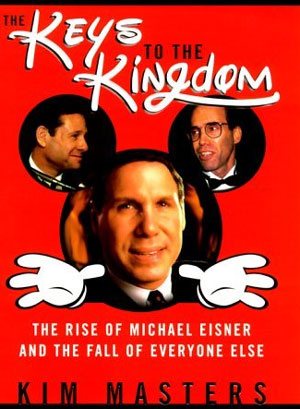
Copyright HarperCollins Publishers, Inc.
All rights reserved
"And how did Universal react to this news?," you query.
Well, as Kim Masters recounted in her 2000 book, "Keys to the Kingdom : The Rise of Michael Eisner and the Fall of Everybody Else," Sid Sheinberg (i.e. MCA/Universal's
then-president and COO) clearly missed the good old days when people like Jules
Stein & Walt Disney were the kings of Hollywood. When the competition
between studios was cordial, not quite so cutthroat.
In "Keys of the Kingdom," Masters quotes Sheinberg as saying
that the Disney studio tour attraction was " … a rip-off of a concept that we
worked hard to develop." More importantly, that "… Michael Eisner had been
exposed to a lot of very confidential information and knew (exactly) what our
plans were." But the crew at MCA / Universal ultimately wound up getting snookered by Disney because " … we
were trying to behave by a code of chivalry that I guess was out of date."
There's a lot of story still left to tell here, folks. Especially
when it comes to the brutal PR battle that erupted between Universal & Disney in
the mid-to-late 1980s when it came to who was building the best studio theme
park in Central Florida. More importantly, who stole the ideas for what attractions from whom.
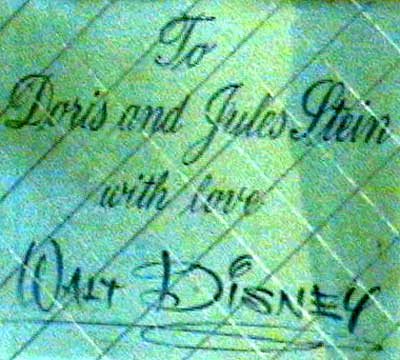
But rather than end things on a down note like that, I'd prefer to
circle back on a better time & place in our narrative. To be specific, the strong friendship / good working relationship that Jules
Stein & Walt Disney had (which is actually commemorated as part of that Mary
Blair-designed mural at the UCLA Eye
Center by the dedication tile depicted above). More importantly, the part that Walt played in the revival
of the Universal Studio Tour. Which can be directly traced back to those three
days that a certain 21 year-old spent exploring the magical movie kingdom which Universal City's backlot used to be back in the 1920s.
Which brings us now to the obvious question: Did Disneyland inspire the Universal Studio Tour in Hollywood? Or was it actually the other way around?
Your thoughts?
Editor's note: My apologies for JHM being a bit light on
content last week. But after that freak Nor'Easter, I initially thought that I'd be able to knock out this how-Walt-influenced-and-impacted-the-Universal-Studio-Tour
story in just a day or so. But six days later … Well, there's still a ton of
material that I wasn't able to fold in here. Which brings me to my question: Would you
guys be interested in more stories that look back on the Disney /
Universal theme park wars of the late 1980s / early 1990s? If so, please let me
know. And I'll then see if I break this "War And Peace" -length narrative into a more
Web-friendly format.
Television & Shows
The Untold Story of Super Soap Weekend at Disney-MGM Studios: How Daytime TV Took Over the Parks

A long time ago in a galaxy that … Well, to be honest, wasn’t all that far away. This was down in Florida after all. But if you traveled to the WDW Resort, you could then experience “Star Wars Weekends.” Which ran seasonally at Disney’s Hollywood Studios Disney World from 1997 to 2015.
Mind you, what most folks don’t remember is the annual event that effectively plowed the road for “Star Wars Weekends.” Which was “Super Soap Weekend.” That seasonal offering — which allowed ABC soap fans to get up-close with their favorite performers from “All My Children,” “General Hospital,” “One Life to Live” and “Port Charles” — debuted at that same theme park the year previous (1996).
So how did this weekend-long celebration of daytime drama (which drew tens of thousands of people to Orlando every Fall for 15 years straight) come to be?
Michael Eisner’s Daytime TV Origins and a Theme Park Vision
Super Soap Weekend was the brainchild of then-Disney CEO Michael Eisner. His career in media began with short stints at NBC and CBS, but it truly took off in 1964 when he joined ABC as the assistant to Leonard Goldberg, who was the network’s national programming director at the time.
Eisner quickly advanced through the ranks. By 1971, he had become Vice President of Daytime Programming at ABC. That meant he was on the scene when One Life to Live joined the lineup in July 1968 and when All My Children made its debut in January 1970. Even after being promoted to Senior Vice President of Prime Time Programming in 1976, Eisner stayed close to the daytime division and often recruited standout soap talent for ABC’s primetime shows.
Fast forward nearly two decades to July 31, 1995. The Walt Disney Company announced that it would acquire ABC/Cap Cities in a $19 billion deal. Although the acquisition wasn’t finalized until February 1996, Eisner was already thinking ahead. He wanted to use the stars of All My Children, One Life to Live, and General Hospital to draw people to Disney’s theme parks.
He had seen how individual soap stars were drawing huge mall crowds across America since the late 1970s. Now he wanted to bring dozens of them together for something much bigger.
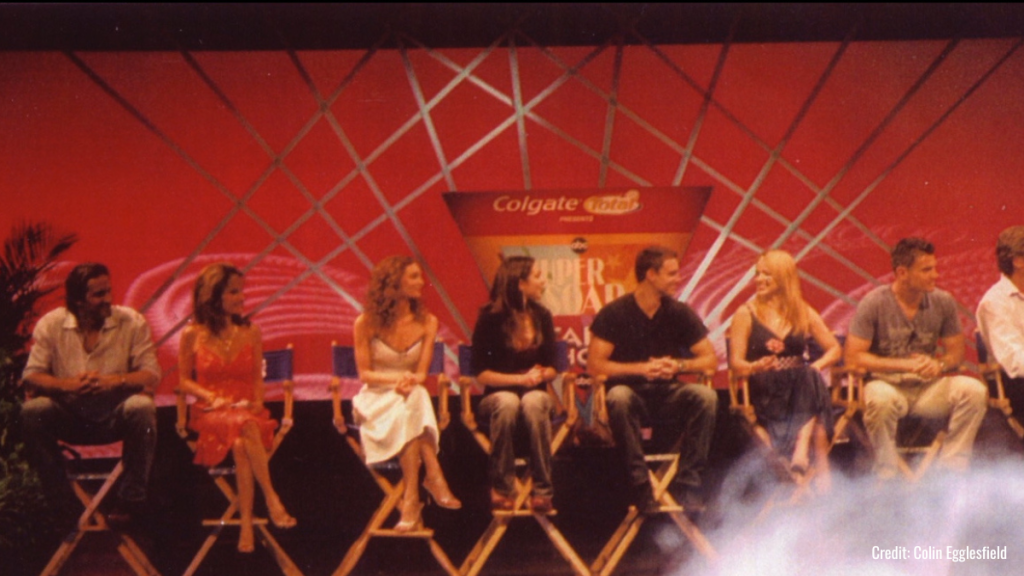
Super Soap Weekend Takes Over Disney-MGM Studios
The very first Super Soap Weekend was announced in June 1996, just a few months after the ABC deal closed. The event was scheduled for October 19 and 20 at Disney-MGM Studios and was a massive success.
The weekend featured panel discussions, autograph sessions, and photo opportunities with the stars of ABC’s daytime dramas. Thousands of fans packed the park for the chance to meet their favorite actors. Due to the overwhelming response, the event became an annual tradition and was eventually moved to Veterans Day weekend each November to better accommodate attendees.
Longtime fans like Nancy Stadler, her mom Mary, and their close friend Angela Ragno returned year after year, making the event a personal tradition and building lifelong memories.




West Coast Events and the ABC Soap Opera Bistro
Disney even tried to recreate the event out west. Two Super Soap Weekends were held at Disneyland Resort, one in April 2002 and another in June 2003.
At Disney’s California Adventure, Eisner also introduced the ABC Soap Opera Bistro, a themed dining experience that opened in February 2001. Guests could dine inside recreated sets from shows like General Hospital and All My Children, including Kelly’s Diner and the Chandler Mansion. The Bistro closed in November 2002, but for fans, it offered a rare opportunity to step into the world of their favorite soaps.
SOAPnet, Port Charles, and the Expansion of Daytime TV at Disney
Eisner’s enthusiasm for soaps extended beyond the parks. In January 2000, he launched SOAPnet, a cable channel dedicated to prime time replays of ABC’s daytime dramas.
During his time at Disney, General Hospital also received a spin-off series titled Port Charles, which aired from June 1997 to October 2003. The show leaned into supernatural plotlines and was another example of Eisner’s commitment to evolving and expanding the soap genre.
The Final Curtain for Super Soap Weekend
In September 2005, Eisner stepped down after 21 years as head of The Walt Disney Company. Bob Iger, who had previously served as President of ABC and Chief Operating Officer of ABC/Cap Cities, took over as CEO. While Iger had deep ABC credentials, he didn’t share Eisner’s passion for daytime television.
In the fall of 2008, Disney hosted the final Super Soap Weekend at what was then still called Disney-MGM Studios. That same year, the park was rebranded as Disney’s Hollywood Studios, and Disney began shifting away from television-focused experiences.
Within the next five years, the rest of Eisner’s soap legacy faded. One Life to Live was canceled in January 2012. SOAPnet was rebranded as Disney Junior in February 2013. Later that year, All My Children ended its 41-year run on ABC.
Only General Hospital remains on the network today, the last standing soap from the golden age of ABC Daytime.
A New Chapter for Daytime TV and Super Soap Fans
The soap genre may have faded from its former glory, but it’s not gone. On February 24, 2025, CBS premiered a brand-new daytime drama called Beyond the Gates, marking the first new soap launch in years.
Meanwhile, All My Children alum Kelly Ripa has been actively working on a revival. In September 2024, she mentioned a holiday-themed movie set in Pine Valley that would bring back many original cast members. The project was in development for Lifetime, though its current status is unclear.
And what about Super Soap? Fans like Nancy and Angela still hope Disney will bring it back. Even if it only featured the cast of General Hospital, it would be a welcome return for longtime viewers who miss that one weekend a year where the magic of Disney collided with the drama of daytime TV.
If you want to hear firsthand what it was like to be part of Super Soap Weekend, be sure to listen to our I Want That Too podcast interview with actor Colin Egglesfield. He shares behind-the-scenes memories from his days as Josh Madden on All My Children and what it meant to be part of one of the most unique fan events in Disney park history.
History
The Super Bowl & Disney: The Untold Story Behind ‘I’m Going to Disneyland!’

One of the highlights of the Super Bowl isn’t just the game itself—it’s the moment when the winning quarterback turns to the camera and exclaims, “I’m going to Disney World!” This now-iconic phrase has been a staple of post-game celebrations for decades. But where did this tradition begin? Surprisingly, it didn’t originate in a stadium but at a dinner table in 1987, in a conversation involving Michael Eisner, George Lucas, and aviation pioneers Dick Rutan and Jeana Yeager.

The Unlikely Beginning of a Marketing Sensation
To understand the origins of this campaign, we have to go back to December 1986, when the Rutan Voyager became the first aircraft to fly around the world without stopping or refueling. Pilots Dick Rutan and Jeana Yeager completed the nine-day journey on December 23, 1986, flying over 26,000 miles before landing at Edwards Air Force Base. Their historic achievement earned them national recognition, and just days later, President Ronald Reagan awarded them the Presidential Citizen Medal at the White House.
Meanwhile, Disney was gearing up for the grand opening of Star Tours at Disneyland, set for January 12, 1987. Following its usual playbook of associating major theme park attractions with real-world pioneers, Disney’s PR team invited astronauts Gordon Cooper and Deke Slayton to the launch event. But in a twist, they also invited Rutan and Yeager, who were still making headlines.

A Dinner Conversation That Changed Advertising Forever
After the Star Tours opening ceremony, a private dinner was held with Disney CEO Michael Eisner, George Lucas, and Eisner’s wife, Jane. During the meal, Eisner asked Rutan and Yeager, “You just made history. You traveled non-stop around the planet on a plane without ever refueling. How are you ever going to top that, career-wise? What are you two gonna do next?”
Without hesitation, Jeana Yeager replied, “Well, after being cramped inside that tiny plane for nine days, I’m just glad to be anywhere else. And even though you folks were nice enough to fly us here, invite us to your party… Well, as soon as we finish eating, I’m gonna go over to the Park and ride some rides. I’m going to Disneyland.”
Jane Eisner immediately recognized the power of Yeager’s statement. On the car ride home, she turned to Michael and said, “That’s a great slogan. I think you should use that to promote the theme parks.” Like many husbands, Michael initially dismissed the idea, but Jane persisted. Eventually, Eisner relented and pitched it to his team.
The Super Bowl Connection
With Super Bowl XXI just around the corner, Disney’s PR team saw an opportunity. The game was set for January 25, 1987, at the Rose Bowl in Pasadena—just miles from Disney Studios. What if they convinced the winning quarterback to say, “I’m going to Disneyland” live on-air?
Disney quickly struck a deal with both quarterbacks—Phil Simms of the New York Giants and John Elway of the Denver Broncos—offering each $75,000 to deliver the line if their team won. Simms led the Giants to victory, making history as the first athlete to say, “I’m going to Disney World!” on national television.
A Marketing Triumph
That year’s Super Bowl had the second-highest viewership in television history, with 87 million people watching Simms say the famous line. The next day, Disney turned the clip into a national commercial, cementing the phrase as a marketing goldmine.
Since then, “I’m going to Disneyland” (or Disney World, depending on the commercial) has been a staple of championship celebrations, spanning the NFL, NBA, and even the Olympics. What started as a casual remark at dinner became one of the most successful advertising campaigns in history.
A Lasting Legacy
Jane Eisner’s keen instinct and Disney’s ability to act quickly on a great idea created a tradition that continues to captivate audiences. The “I’m going to Disneyland” campaign remains a testament to the power of spontaneous inspiration and smart marketing, proving that sometimes, the best ideas come from the most unexpected places.
To learn more about Disney’s ties to the world of sports, check out I Want That Too: A Disney History and Consumer Product Podcast.
Television & Shows
How the Creators of South Park Tricked A-List Celebrities to Roast Universal – “Your Studio & You”
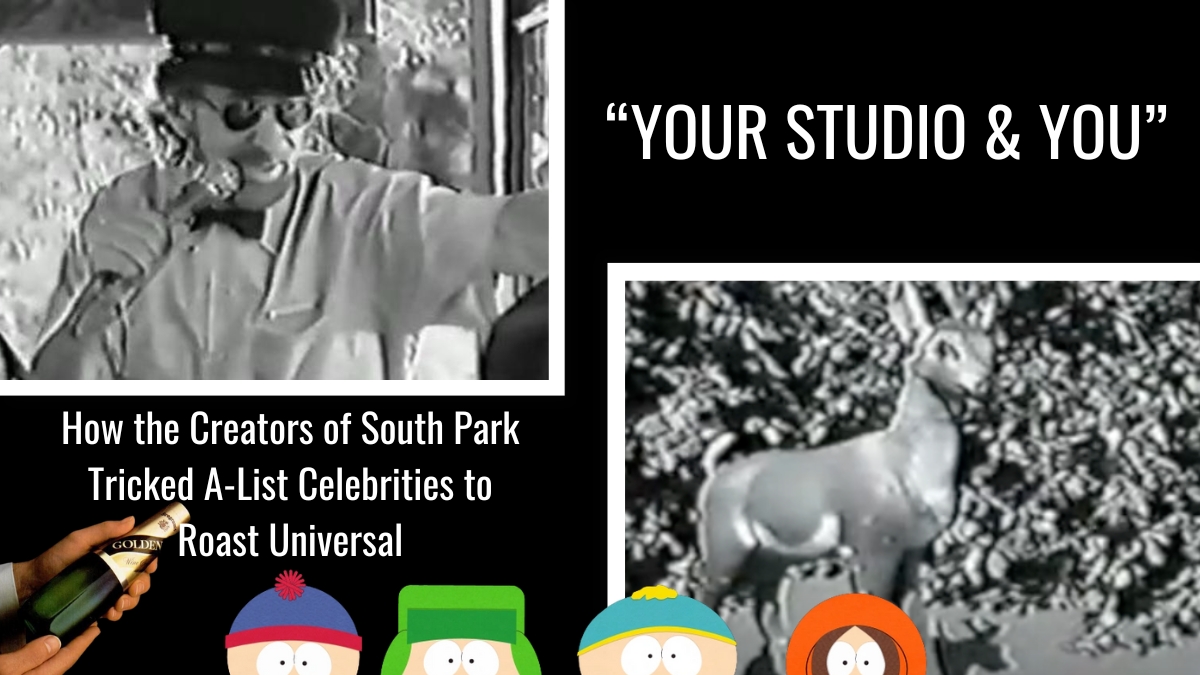
Universal Studios has a rich and storied history, but few moments are as peculiar—and as hilariously cutting—as the creation of Your Studio & You. This 14-minute parody film, commissioned in 1995 to celebrate Universal’s new ownership under Seagram’s, brings together an all-star cast, biting humor, and the unmistakable comedic fingerprints of Matt Stone and Trey Parker.
Long before South Park debuted on Comedy Central in 1997, Stone and Parker were already carving out a reputation for their irreverent style, and Your Studio & You perfectly encapsulates their knack for turning even the most corporate project into something delightfully subversive.
Matt Stone & Trey Parker Before South Park
Stone & Parker were already known out in Hollywood as funny guys. Thanks largely to “The Spirit of Christmas,” which was this video greeting card that they’d crafted for a Fox executive – who then distributed this infamously funny thing (which had Our Lord Jesus Christ & Santa Claus literally duking it out for the holiday affections of Cartman, Kenny, Stan & Kyle) to friends & family.
This was the early 1990s. No internet. Each copy of “The Spirit of Christmas” was made on VHS tape and then mailed. Went viral the old-fashioned way. It’s rumored that George Clooney made over 300 copies of “The Spirit of Christmas” and passed these VHS taps along to friends and family.
Things didn’t move as fast as they do today. “The Spirit of Christmas” still became a sensation out West.
Zucker Brothers
Matt & Trey also had other supporters in the entertainment industry. Among them David Zucker, who was one of the members of ZAZ (i.e., Zucker Abrahams Zucker), the talented trio that made “Airplane!” in 1980, “Top Secret!” in 1984 and the three “Naked Gun” movies.
- The original “Naked Gun” in 1988
- “Naked Gun 2 & 1/2 : The Smell of Fear” in 1991
- and “Naked Gun 33 & a 1/3: The Final Insult” in 1994
All five of these parody films had been made for Paramount Pictures. But in the Late Winter / Early Spring of 1995, Universal had persuaded the Zucker Brothers to come over and set up shop in a bungalow on their lower lot. With the hope that – at some point further on down the line – David & his brother Jerry would start making funny films for Universal.
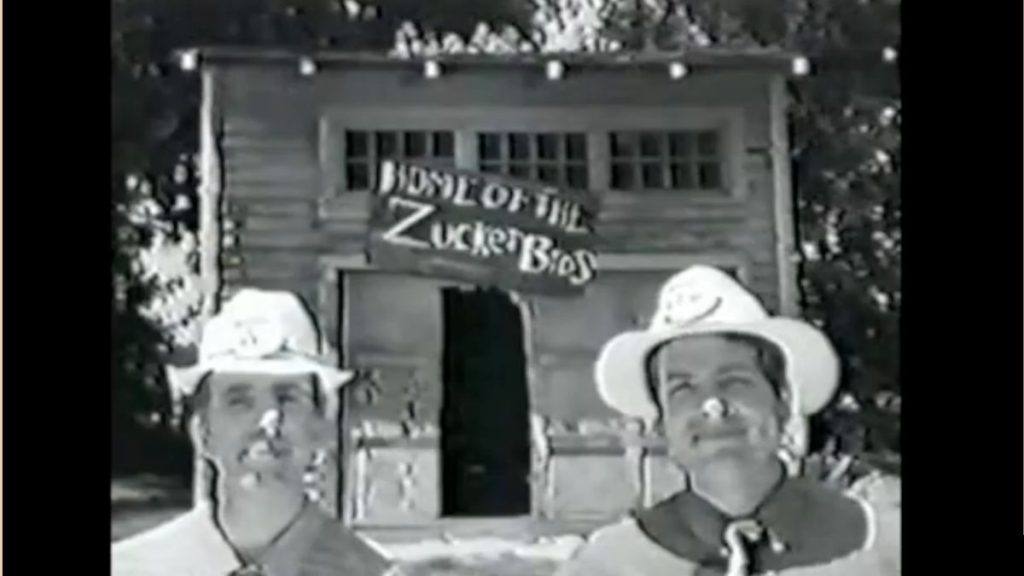
And it’s during this same window of time (We’re now talking April of 1995) that news breaks that Seagrams (Yep, the adult beverage company. Who – at the time – was making an absolute fortune on the sales of wine coolers) was about to buy a majority stake in MCAUniversal. We’re talking control of 80% of that company’s stock. Which would effectively make Seagrams the new owners of Universal Studios.
Edgar Bronfman
And Edgar Bronfman – the owner of Seagrams – knew that Universal had had a tough time with its previous owners – which had been the Matsushita Electric Industrial Co. of Japan. Matsushita had bought MCA back in November of 1990 for $7.5 billion but had never really understood the entertainment industry.
This is why – after repeatedly butting heads with Lew Wasserman & Sidney Sheinberg (i.e., the heads of Universal Studios & the Universal theme park respectively) when it came to creative control of this company – Matsushita decided to wash it hands of the entire enterprise. Agreeing to sell their holdings in MCA to Seagrams for $5.7 billion (effectively taking a nearly $2 billion loss on this investment).
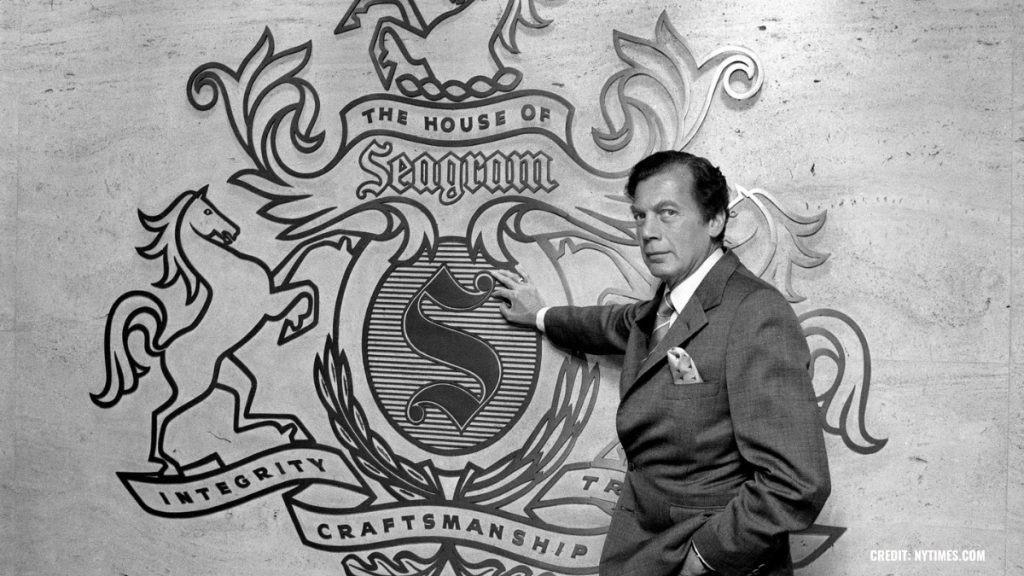
And Bronfman … He knew that some bad feeling had developed between Hollywood’s creative community and the Japanese owners of Universal. The thinking was that executives at Matsushita Electric had just not gotten what it took to make movies & TV shows.
And Edgar? Right from the get-go, he wanted to show that Seagrams was NOT going to be Matsushita Electric Redux. Bronfman was looking for a way to send a clear message to Hollywood’s creative community that Universal’s new owners got it. That they were willing to work with Hollywood to make the best possible movies & TV shows at Universal.
And how did Edgar decide to get this message across? By making a funny movie.
Zucker Commissions Trey Parker for “Your Studio & You”
Mind you, Bronfman himself didn’t make this film. The owner of Seagrams reached out to David Zucker. Who – after initially agreeing to produce this introduction-to-Universal film – then farmed out the production of the actual project to Trey Parker. Who – just two days before shooting was supposed to star on the Universal Lot – persuaded Matt Stone to come help him on this project.
Which brings us to “Your Studio and You.” Which is a parody of an educational film from the 1950s, right down to being shot in black & white and featuring a very generic soundtrack.
Now what’s amazing about watching “Your Studio and You” today is that this 14-minute-long film features some of the biggest names working in Hollywood back in the mid-1990s. We’re talking about people like recent Golden Globe winner Demi Moore, Sylvester Stallone, Michael J. Fox and Angela Lansbury. Not to mention two of the most powerful men in all of Hollywood, Steven Spielberg & Jeffrey Katzenberg.
And what’s especially interesting about watch “Your Studio and You” is that – as you watch these performers go through their paces in this motion pictures (which – most of the time – involves doing some innocuous task while holding a Seagram’s wine cooler) – you often get the feeling that this star is not in on the gag.
So how did Matt & Trey get away with this? Simple. There was never actually a script for “Your Studio and You.”
Filming “Your Studio & You” at Universal Studios Hollywood
Mind you, David Zucker would always insist that there was. Especially when he’d phone up celebrities on the Universal Lot and say “Hey, I’m sending over a couple of college kids later today. They’re working with me on a new parody film. It’s something that we’re doing for the new owners of Universal. I need just a half hour of your time. We’re shooting something special for the party we’ll be holding when the Seagrams people first arrive at the Studio. Absolutely. You’ll definitely get an invite to that party. So can I count on you to help these kids out? Beautiful. They’ll be over there later this morning.”
And then Matt & Trey would show up and say “… Dang, Miss Lansbury. We’re sorry. We must have left our copy of the ‘Your Studio and You’ script back in our office. Which is clear on the other side of the Lot. So – rather than waste your time – why don’t we do this instead? Follow us over to the Psycho House. Where we’re then going to get footage of you painting the front porch on Mother Bates’ house while you say ‘Gosh, with all of the wonderful improvements going on around here, everyone is going to want to work at Universal.’ Oh, and can we also get you to wear this button on the front of your blazer which reads ‘Universal is A-OK’ ? “

And over & over again, the biggest names who were working for Universal at that time took part in the production of “Your Studio & You” because A) David Zucker vouched for Matt Stone & Trey Parker and B) this was something that was being made for the new owners of Universal. And it’s just natural to want to get in good with the new boss.
Steven Spielberg, Jeffery Katzenberg, and Jaws
But no one at Universal anticipated that “Your Studio & You” would wind up being as sharp edged as the finished product turned out to be. I mean, it’s one thing to bite the hand that feeds you. But “Your Studio & You” ? It doesn’t just bite the hand. It takes the hand off at the wrist.
It’s a brutally funny film. With one of the meanest moments reserved for Steven Spielberg, who plays a driver on the Universal Studio Tour who’s trying to persuade a tram full of bored tourists (one of whom is played by Jeffery Katzenberg) that the “Shark Attack” scene down by Jaws Lagoon is actually exciting.
Spielberg actually says lines like “ … Whoa, whoa. What is going on here? Ladies and gentlemen, this never happens. Look out! It’s a shark! Whoa, that is one big scary shark.”

Mind you, as footage of this mechanical shark repeatedly coming up out of the water is shown, “Your Studio & You” ‘s off-screen narrator (who is voiced by Trey Parker says):
“But what about tomorrow? If we don’t keep in step with the times, things that were once neat and thrilling can become old and stupid.”
“Your Studio & You” Reception
This film was supposed to be shown only once at the welcoming party for Seagrams executive on the Universal Lot. And I’m told that – when Edgar Bronfman saw the finished product at that party – he reportedly turned to David Zucker and said “ … That’s a little more mean-spirited that I think it needed to be.”
And with that, “Your Studio & You” was supposed to go back into the Universal vault, never to be seen again. But when “South Park” debuted on Comedy Central in August of 1997 and then became a sensation for its biting humor, there was suddenly a lot of interest in what else Matt & Trey had done. Which is why copies of “The Spirit of Christmas” began to circulate. And – over time – copies of “Your Studio & You” began to bubble up.
Which – as Stone & Parker have repeatedly pointed out – was just not supposed to happen. Largely because none of the celebrities who appeared in “Your Studio & You” had never signed releases for Universal’s legal department. Because – again – this was for a movie that was only going to be shown once at a private function on the Universal Lot.
Matt mentioned (as part of a career retrospective at the Paley Center in LA back in 2000) that “ … they wouldn’t even let us keep a copy of the finished film.”
It’s a funny but brutal movie. And worth taking a look at today especially if you’re a theme park history buff because it shows Universal Studios Hollywood’s “Jurassic Park: The Ride” still under construction on the Lower Lot. That attraction would finally open to the public in June of 1996.
“Your Studio & You” became a lot easier to see after Seagrams sold off its share of Universal to Vivendi in 2000. Copies began propagating online after that. Though Universal Legal will periodically make an effort to get the latest copy of “Your Studio & You” taken off the Internet because – again – none of the performers who appear on camera ever signed the proper releases and/or were paid for their efforts.
That said, if you’re up for a mean-spirited laugh, “Your Studio & You” is well worth 14 minutes of your time. That said, once you watch this thing, be warned:
- You’re immediately going to be thirsty for a Seagram’s wine cooler
- And you’re going to have a sudden desire to go out & buy a porcelain deer.
-

 Theme Parks & Themed Entertainment8 months ago
Theme Parks & Themed Entertainment8 months agoDisney’s Forgotten Halloween Event: The Original Little Monsters on Main Street
-

 Theme Parks & Themed Entertainment8 months ago
Theme Parks & Themed Entertainment8 months agoThe Story of Mickey’s Not-So-Scary Halloween Party: From One Night to a Halloween Family Tradition
-

 Film & Movies8 months ago
Film & Movies8 months agoHow “An American Tail” Led to Disney’s “Hocus Pocus”
-

 Theme Parks & Themed Entertainment6 months ago
Theme Parks & Themed Entertainment6 months agoDisney and Macy’s 90-Year Thanksgiving Day Parade Partnership: From Mickey’s First Balloon to Minnie’s Big Debut
-

 Television & Shows4 months ago
Television & Shows4 months agoHow the Creators of South Park Tricked A-List Celebrities to Roast Universal – “Your Studio & You”
-

 History3 months ago
History3 months agoThe Super Bowl & Disney: The Untold Story Behind ‘I’m Going to Disneyland!’
-

 Podcast1 month ago
Podcast1 month agoEpic Universal Podcast – Aztec Dancers, Mariachis, Tequila, and Ceremonial Sacrifices?! (Ep. 45)
-

 Television & Shows3 weeks ago
Television & Shows3 weeks agoThe Untold Story of Super Soap Weekend at Disney-MGM Studios: How Daytime TV Took Over the Parks






